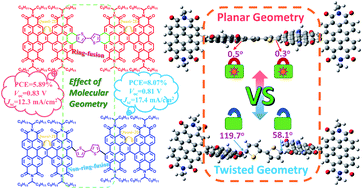Fusion or non-fusion of quasi-two-dimensional fused perylene diimide acceptors: the importance of molecular geometry for fullerene-free organic solar cells†
Abstract
In this work, two small molecular electron acceptors (BT–FPDI and fBT–FPDI) comprising a central bithiophene (BT) bridge and two fused perylene diimide (FPDI) units were designed and synthesized for fullerene-free organic solar cells (OSCs). The molecular geometry of these electron acceptors can be adjusted through a locked conformation via a photocyclization reaction. As expected, BT–FPDI has a highly twisted geometry with the assistance of the quasi-two-dimensional (quasi-2D) configuration of the FPDI unit and modest dihedral angles between FPDI and BT units, while fBT–FPDI shows a relatively planar geometry with symmetrically aligned FPDI wings. When paired with polymer donor PTB7-Th, the intrinsic configuration characteristic of BT–FPDI guaranteed an impressive power conversion efficiency (PCE) of 8.07% with an open circuit voltage (Voc) of 0.81 V, and a record high short-circuit current density (Jsc) of 17.35 mA cm−2, which is almost the highest Jsc value reported for PDI-based fullerene-free OSCs. However, the optimal device employing fBT–FPDI as an electron acceptor delivered a PCE of only 5.89% with a significantly reduced Jsc of 12.30 mA cm−2. The interesting results show that, unlike traditional PDI molecules, the ring-fusion molecular design did not produce the desired positive effect in FPDI derivatives, and also provide a new insight into the regulation of the molecular geometry based on FPDI acceptors with an intrinsic quasi-2D structure.



 Please wait while we load your content...
Please wait while we load your content...